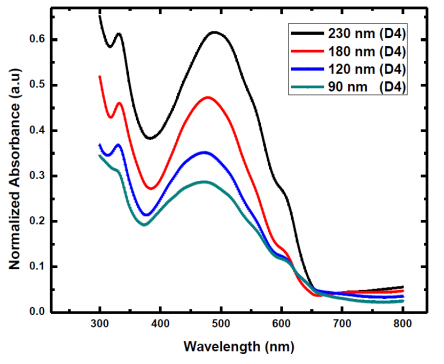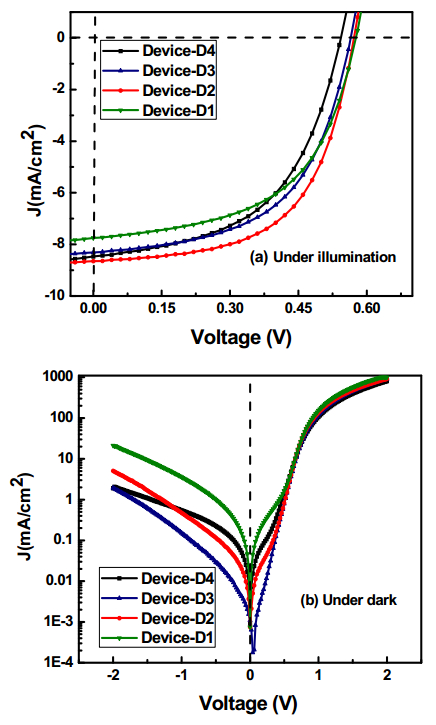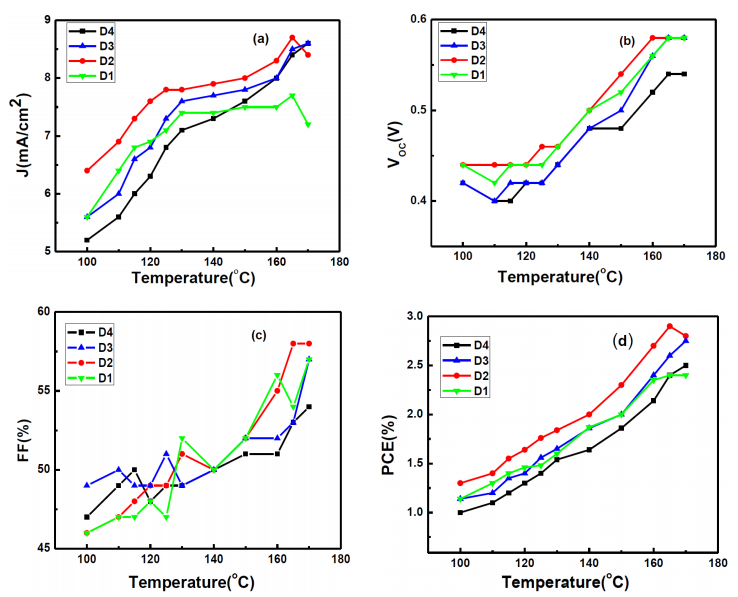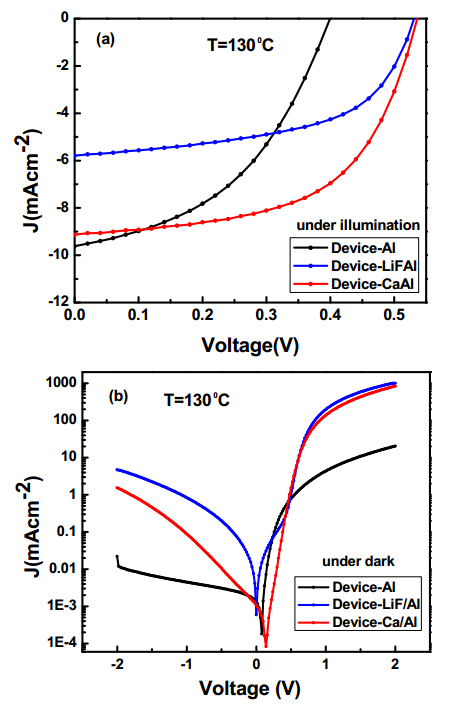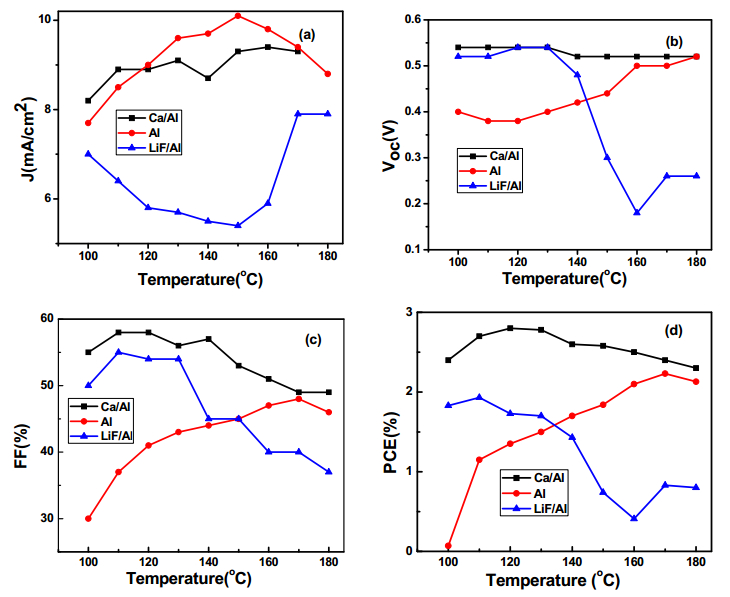1. Introduction
Organic solar cell devices, processed from solution at room temperature, have been attracting great attention of scientific communities during the past decades owing to their low materials cost, mechanically flexible, easy fabrication over large-area substrates. The most common structure of such devices consists of donor and acceptor phases. These phases contain the electron donor and hole transporting materials, such as poly (3-hexylthiophene) (P3HT), and an electron acceptor and transporting materials, such as (6, 6)-phenyl C61 butyric acid methyl ester (PCBM). The acceptor and donor materials were blended together to form bulk films [1,2,3] for the devices, called bulk heterojunction organic solar cells, and have been widely investigated [4,5,6,7,8,9,10,11]. The bulk-heterojunction-solar-cell-devices concept led to enhance the short-circuit current of organic solar cell and resulting higher-power-conversion (PCE) efficiency up to 10% [12,13,14,15]. Active-layer film-thickness is a critical component of the organic solar cells devices. Tuning the device's active-layer thickness, is a point of worth noting to get optimum optical absorption, increasing charge carriers transport, and hence enhancing power conversion efficiency [16,17]. However, the active-layer thickness must be comparable to the excitons diffusion/dissociation range to suppress internal as well as contact resistances and get efficient device controlling parameters [18]. Different active-layer thicknesses have been selected in between electrodes to achieve high-light harvesting rate [4]. Kirchartz et al. observed that the variation in short circuit current density (JSC) and fill factor (FF) with film thicknesses are due to the mobility and lifetime before recombination or decay, of the charge carriers [19]. Few attempts have been made on addressing the improvement of device efficiency through materials and metal electrode optimization with different light trapping strategies [20,21,22]. Various composition layers have been incorporated in between electrode and photoactive materials [23,24,25,26]. The insertion of thin layer of LiF or Ca before Al metal electrode deposition is to reduce the interfacial resistance and prevent quenching of excitons due to particular interaction at the interface [27,28]. It is also crucial to enhance the fill factor (FF) significantly and maintain high-open-circuit voltages (Voc) of the devices with optimum value of temperature [29]. Thermal annealing improves absorption coefficient due to film morphology, facilitates the phase separation, thereby enhances crystallinity, increases excitons-generation rates and strengthens electrical polarizations in the P3HT:PCBM blend [7,8,30]. Thermal treatment of the P3HT/PCBM-based organic photovoltaic OPV devices is to recover the order structure of P3HT that is disrupted in the presence of PCBM during bulk film fabrication and, more interestingly, also increase the P3HT molecule chains π–π overlapping [9,12,13,31,32]. Thermal annealing on the blend films (P3HT/PCBM) plays an important role in the OPV device application. It can help to reduce series resistance of the device as well as improve the interfacial contacts between the electrodes [16,32]. Despite the various advantages over its conventional inorganic counterparts, organic solar cells have some limitations like low-charge-carrier mobility and short exciton life time [33,34,35]. Among the variety of device's active-layer-deposition techniques, spin coating, beside some limitations, is quite fast, easy and quite common to fabricate solution-processed active-layers thin and homogeneous films for optoelectronic devices [33]. A prerequisite for getting the high efficiency is optimizing the device-fabricating parameters, such as active layer thickness, post deposition annealing and cathode material layer etc. Donor and acceptor layer should have optimum thickness to harvest sufficient light and obtain efficient charge-carrier generation. Furthermore, the electrode materials are required to have an efficient charge-carrier extraction and low or non-resistive transportation. Hereby, the thickness of the donor and acceptor material, thermal annealing and inter-layer, sandwiched between top electrode and active layer, are important device parameters.
In this paper, we focus on optimization of various parameters based on P3HT:PCBM blend active layers. To this aim, optimization of the device active-layers thicknesses, top electrodes and the effect of post-thermal treatment were investigated. Initially, we deposited device's bulk layer from optimum solution concentration in order to address thickness effect. Secondly, three set of devices with different schemes of top electrode, such as Al, LiF/Al, and Ca/Al, were used. The electrical characterization is carried out to measure the effect of thermal annealing on short-circuit current, open circuit voltage, fill factor and power conversion efficiency at different active-layer thicknesses and different top electrodes.
2. Materials and Method
In this work, the spin coating process was used to prepare the active layers for organic solar cells. Commercially available P3HT (Plextronics) and PC61BM (Solaris) were used without further purification. Indium-tin-oxide (ITO) substrates, with 15 Ω/cm2 sheet resistance, were used as transparent conducting electrode. ITOs were cleaned in successive solutions of acetone, ethanol and isopropanol respectively. The substrates were sonicated for 15 minutes in each solvent. The transparent hole-conducting-polymer film around 30 nm, poly(3, 4-ethylenedioxythiophene):polystyrene sulfonate (PEDOT:PSS) (Aldrich) was subsequently spin-coated from water solution on ITO/glass substrates at 4000 rpm for 40 seconds. The films were, then, annealed at 110 ℃ for 30 minutes. Device's active layers were prepared from the 40 mg/ml blend-concentrated solution (P3HT/PCBM) (1:1 w/w), dissolved in dichlorobenzene, using various spin-coating speed in the range of 2000 rpm to 5000 rpm under N2 atmosphere. Thicknesses of active layers of devices were confirmed, using KLA-Tencor Alpha step 500 profilometer, to be 230 nm, 180 nm, 120 nm and 90 nm, and labeled as D4, D3, D2 and D1, respectively, for simplicity. Top metal electrodes with a scheme, such as Al, LiF/Al and Ca/Al, were evaporated through electron beam. UV-vis spectra of thin film of various devices in term of thicknesses were recorded over the spectral range of 300–800 nm using spectrometer (Perken Elmer λ 25). A 100-nm thick aluminum electrode was thermally deposited by electron-beam-evaporation process at a base pressure of 5 × 10−7 mbar onto the active layer using shadow mask to define an active-device area of 10 mm2 to complete the devices. Fabricated organic-bulk-heterojunction solar cells with Al and thin layer (20 nm) of LiF/Ca Al, evaporated via e-beam evaporation, are shown in Figure 1a and 1b, respectively. Current-density-voltage (J-V) characteristics of devices were examined under solar simulated AM1.5G irradiation (100 mW·cm−2) using a Keithley (2400 source measuring unit a reference Si solar cell).
3. Results and Discussion
To improve the light absorption, active material with varying thicknesses has been introduced. Optical absorbance spectra were measured which infer clearly the thickness effect on the photon absorption, indicated in Figure 2. Absorption of films at visible range of 400–580 nm decreased significantly with decreasing thickness. A descending trend in the absorption is clearly viewed while going from the thicker, 230 nm (black), to thinner, 90 nm (dark green), film. The observations recorded indicate efficient-photon absorption by increasing the number density and hence generating charge carriers. Shoulder peaks around 600 nm were observed for all spectra that indicates well-ordered structure of P3HT molecules [36,37].
Figure 3 shows current-density-voltage characteristics of the organic phtovoltaics (OPVs) with optimum annealing temperature of 165 ℃. It is observed that there is not much difference in the open-circuit voltage of the OPVs while changing the thickness of devices, whereas short-circuit current-density gradually increases to the optimum thickness, due to stronger built-in electric field which results in shorter pathways for charge carriers to their respective electrodes. Also increase in JSC, upon high annealing temperature, shows a thermally excited hopping in these disordered systems [38]. The probability of exciton recombination is relatively high in the thicker films. Therefore, the device D2 (120-nm thick and fabricated with 4000-rpm spin-coating speed) shows an enhanced performance compared to the rest of the three devices. The enhanced device parameters, such as short-circuit current density, open-circuit voltage fill factor, and power-conversion efficiency were obtained at annealing temperature of 165 ℃, as reported in Table 1. Low series resistance of 9 ohms and high shunt resistance of 1027 ohms, showing good diode behavior with high rectification and high fill factor, suggest less recombination effect.
Table 1. Summary of OPVs parameters, Jsc, Voc, FF, and PCE, of devices with different thicknesses at optimized annealed temperature of 165 ℃ having Al as top electrode.
| Devices |
Jsc (mA/cm2) |
Voc (V) |
FF (%) |
PCE (%) |
| D4 |
8.4 |
0.54 |
53 |
2.4 |
| D3 |
8.5 |
0.58 |
53 |
2.6 |
| D2 |
8.7 |
0.58 |
58 |
2.9 |
| D1 |
7.7 |
0.58 |
54 |
2.4 |
The thermal annealing effect was observed by plotting device parameters versus annealing temperature varying from 100 ℃ to 170 ℃ as illustrated in Figure 4. The more is the annealing temperature of devices, the higher is their performance within the range of optimum value of annealing temperature. It was also noted that thermal treatment increases the power-conversion efficiency, probably due to the improvement in interfacial contacts, within the optimum value of active-layer thicknesses, hence reducing the series resistance.
To address the optimization of top-electrode effect on OPVs, a thin layer of LiF and Ca were deposited between Al and organic-active layer in the fabricated bulk heterojunction polymeric solar cells as shown in Figure 1b. The insertion of these thin layers significantly enhances the fill factor and stabilizes the open-circuit voltage of the OPVs.
Current-density-voltage characteristics of the OPVs with different metal electrodes at optimized annealing temperature of 130 ℃ are shown in Figure 5. The parameters of the device with thin layer of LiF and Ca enhance when compared to a device with just Al thin layer. This may be due to either orientation of the LiF/Ca or doping of the device active layer. At this optimum value of annealing temperature and 120-nm thickness, devices' fill factor was enhanced with consistent open-circuit voltage as shown in Figure 6. The organic solar cell with Ca based electrode performed extremely well at lower annealing temperature and obtained power-conversion efficiency of 2.78%. All the device parameters, such as JSC, VOC and FF, were improved at optimum annealing temperature of 130 ℃.
The summary of all devices parameters is reported in Table 2. The high performance is due to the high fill factor, low series resistance of 9.54 ohms and good diode behavior with high rectification.
Table 2. Summary of OPVs parameters of devices at three different top electrodes at optimum thermal annealing of 130 ℃.
| Devices |
Jsc (mA/cm2) |
Voc (V) |
FF (%) |
PCE (%) |
| Al-electrode |
9.6 |
0.40 |
44 |
1.71 |
| LiF/Al-electrode |
5.8 |
0.54 |
54 |
1.70 |
| Ca/Al-electrode |
9.1 |
0.54 |
56 |
2.78 |
The thermal annealing effect was observed by plotting devices parameters with respect to annealing temperature for the three devices as shown in Figure 6.
The increasing trend in overall devices parameters is observed at certain optimum value of annealing temperature. Moreover, increasing the annealing temperature above a certain limit, Al-based device performs better and is consistent with value reported in literature. Whereas the efficiency of both LiF-and Ca-based OPVs decreases with rising annealing temperature, probably due to formation of oxides layer at semiconductor-metal interface. Thermal annealing above 130 ℃ causes oxide layer. This metal-oxide layer is electrically insulating, increases series resistance and creates a transport barrier, eventually degrading the performance of the device as reported in refs [36,37]. Thermal annealing at high temperature increases Voc values of Al device and does not seriously affect Voc values of Ca/Al device probably, the former is less reactive/sensitive to oxygen than the latter at high temperature. Nevertheless, it is not the only reason of bad performance. The performance of these devices could be further improved by optimizing parameters such as the film roughness (morphology), film thickness, decreasing oxidation, solvent selection, blending ratio and the use of other post-growth treatments [39,40,41].
4. Conclusions
We investigated optimum parameters of organic solar cell devices, such as active-layer thickness, annealing temperature, and the role of interlayers before Al deposition. Device D2 with 120 nm active-layer thickness performed well at 10 minutes thermal annealing of 165 ℃, resulting in maximum power-conversion efficiency of 2.9%. Organic solar cells with Ca-based Al contact performed relatively better at lower annealing temperature, and started degrading when the temperature increased above 130 ℃, PCE reached to 2.78% unlike in the case of LiF/Al and Al where it is just 1.7% and 1.71% respectively. In fact, this is owing to their proper energy-level alignment with active materials which facilitates exciton diffusion/dissociation and charge collection to their respective electrodes. Therefore, thermal annealing has a significant role on the overall performance of the devices. In summary, with optimum parameters the performance of polymeric solar cells can be improved but the issue of stability of such devices is yet to be addressed.
Acknowledgement
The author thanks the Higher Education Commission (HEC) of Pakistan for sponsoring the research Project No: PM-IPFP/HRD/HEC/2012/4021.
Conflict of Interest
The authors declare that there is no conflict of interest regarding the publication of this manuscript.









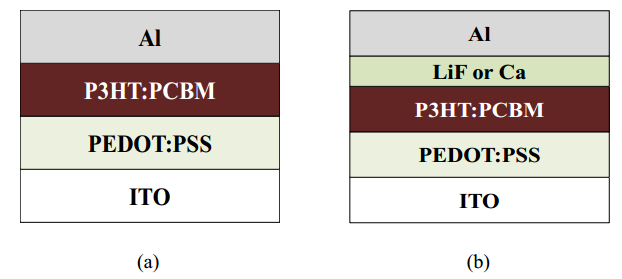
 DownLoad:
DownLoad: 